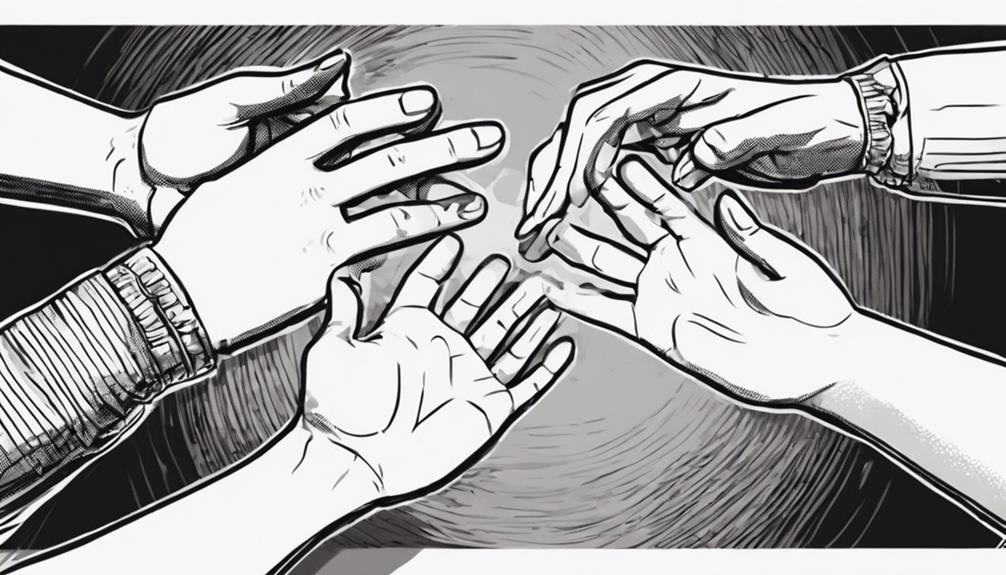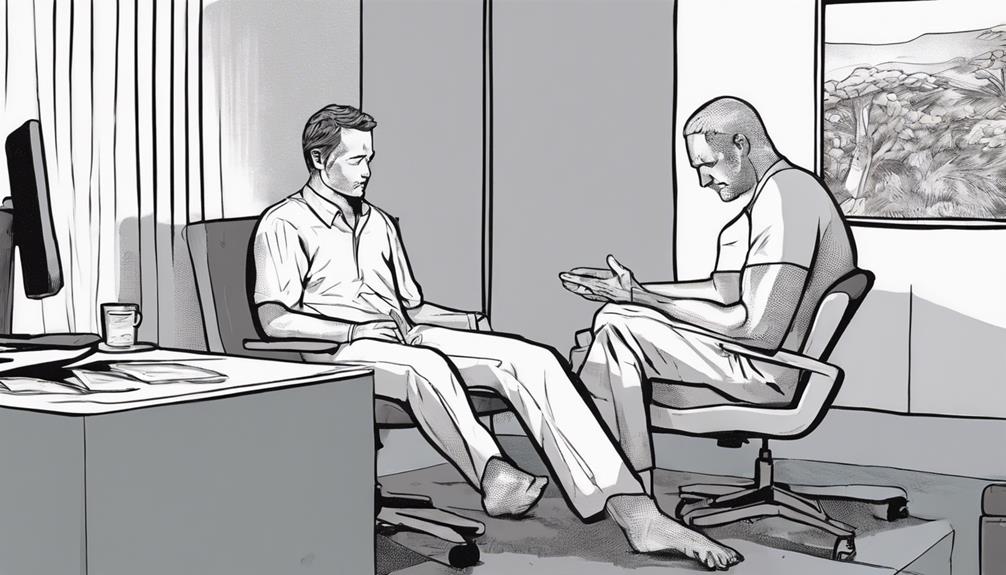Experience how Relational Somatic Therapy unites mind, body, and emotions for holistic healing. This approach merges somatic practices with relational dynamics, promoting self-awareness and emotional regulation. By tapping into physical experiences and introspection, past relational traumas' impact becomes clear. Engaging in this therapy nurtures emotional regulation and deepens your mind-body connection. Discover how this therapeutic method transforms your well-being and relationships by exploring the interconnectedness of your mind, body, and emotions.
Key Takeaways
- Relational somatic therapy integrates mind, body, and emotions for holistic healing.
- It enhances self-awareness, emotional regulation, and interpersonal connections.
- The therapy explores past relational traumas' impact through physical experiences and introspection.
- Techniques involve investigating body sensations, recognizing bodily cues, and addressing past traumas.
- Therapeutic progress is monitored through therapist-client trust, somatic responses, and regular evaluations.
Meaning

Relational somatic therapy examines the interconnectedness of the mind, body, and emotions to foster holistic healing. This therapy combines somatic practices with relational dynamics to help you investigate the relationship between your body and emotional well-being.
By focusing on the mind-body connection, relational somatic therapy aims to enhance your self-awareness, emotional regulation, and interpersonal connections. Through physical experiences and deep introspection, you can start to comprehend how past relational traumas have impacted your overall well-being.
The integration of somatic practices into therapy sessions allows you to explore how your body retains past experiences and emotions. By bringing awareness to physical sensations and movements, you can begin to process and release stored emotions. This process not only aids in emotional regulation but also facilitates a deeper understanding of how your body and mind are intricately connected.
As you engage in relational somatic therapy, you'll learn to navigate your emotions, strengthen interpersonal connections, and nurture a greater sense of self-awareness.
Benefits

Enhancing your self-awareness and emotional regulation, relational somatic therapy fosters deep connections between your mind and body. By incorporating somatic therapy techniques, this approach helps individuals address mental health challenges and navigate their healing journey.
Through embodied experiences, you can work through past traumas and stressors, leading to increased resilience and empowerment in your daily life. This therapy not only supports you in regulating your emotions but also in developing secure relationships built on trust and connection.
As you engage in relational somatic therapy, you may find that you're better equipped to cope with life's challenges and setbacks, feeling more grounded and in tune with your inner self. Embracing the mind-body connection facilitated by this approach can bring about profound transformations, empowering you to cultivate a sense of balance and well-being in your life.
Understanding Somatic Therapy

How does somatic therapy differ from traditional talk therapy in addressing psychological pain and trauma? Somatic therapy focuses on the mind-body connection, recognizing that emotional experiences are stored in the body as bodily sensations. This approach, including techniques like somatic experiencing and Eye Movement Desensitization and Reprocessing (EMDR), directly targets trauma held within the body to facilitate emotional healing and trauma recovery. Unlike traditional talk therapy, somatic therapy emphasizes the physical experience of emotions and trauma rather than just verbalizing them.
| Somatic Therapy | Mind-Body Connection | Trauma Recovery |
|---|---|---|
| Emphasizes body | Acknowledges the | Targets trauma |
| sensations | influence of | stored in the |
| emotions on the body | body for healing |
Foundations and Principles

Exploring the foundational principles of somatic therapy reveals the core beliefs and practices that guide therapeutic interventions. Relational Somatic Therapy places a strong emphasis on the interconnectedness of physical and mental health, highlighting the significance of body awareness in healing.
By integrating somatic investigation with relational dynamics, this approach dives deep into the impact of past relationships on one's emotional well-being. Central to this therapy is the focus on fostering secure attachments and processing relational traumas to promote personal growth and healing.
Practitioners of Relational Somatic Therapy assist individuals in maneuvering interpersonal challenges by encouraging them to tune into their bodily sensations and responses within relational contexts. This heightened awareness of the mind-body connection allows for a more holistic understanding of one's experiences and paves the way for transformative healing.
Science and Techniques

Relational Somatic Therapy integrates cutting-edge scientific insights with innovative therapeutic techniques to address the interconnectedness of physical and mental well-being. In this approach:
- Therapists combine somatic therapy with relational dynamics to explore the mind-body connection.
- Emotions regulation is a key focus, with clients learning to manage their feelings through the therapist-client connection.
- Techniques involve investigating body sensations to uncover underlying issues and promote healing.
- The therapy aims to heal past traumas by utilizing body-centered approaches that emphasize the importance of physical experiences in emotional well-being.
By understanding how past experiences manifest in the body, clients can work through and release stored tension, leading to a more integrated sense of self and improved overall well-being.
This approach highlights the importance of the mind-body connection in addressing emotional struggles and fostering personal growth.
Practice and Benefits

You'll now explore the benefits of relational somatic therapy, focusing on how it enhances your relational connections and impacts your relationships.
This approach emphasizes the importance of the therapeutic relationship in your healing journey.
Through a holistic approach, you'll discover the positive effects of integrating somatic techniques with traditional talk therapy.
Benefits of Relational Connection
Building a strong relational connection in somatic therapy is essential for fostering healing and growth. In relational somatic therapy, the therapeutic relationship serves as the foundation for facilitating transformation and well-being. By prioritizing trust, safety, and connection between the therapist and client, individuals can experience profound benefits such as enhanced emotional regulation and resilience.
Trust:
Establishing trust within the therapeutic relationship creates a secure space for clients to explore and process their emotions.
Safety:
Feeling safe allows individuals to explore vulnerable areas without fear of judgment or harm.
Connection:
Building a strong connection with the therapist promotes a sense of belonging and understanding.
Healing:
Through relational connection, clients can navigate past traumas, improve self-awareness, and ultimately experience deep healing and growth.
Therapeutic Impact on Relationships
Improving relationships through a focus on bodily sensations and emotional responses is a key aspect of the therapeutic impact of Relational Somatic Therapy. By delving into how bodily experiences influence interactions, this approach enhances communication, trust, and intimacy.
Therapists guide individuals in recognizing the connection between their physical sensations and their relational dynamics, fostering a deeper understanding of how emotions manifest within relationships. Through regulating emotions and promoting secure attachments, Relational Somatic Therapy aids in developing healthier patterns of relating to others.
Progress and Application

You can explore how relational somatic therapy emphasizes the significance of the therapeutic relationship in influencing your somatic experiences.
Therapists using this approach aim to create a safe space for you to investigate into your embodied encounters and work through past traumas.
Monitoring your progress throughout the therapeutic journey can provide valuable insights into your healing and growth.
Therapeutic Relationships Importance
The foundation of relational somatic therapy's effectiveness lies in the quality of the therapeutic relationship between the therapist and the client. In this form of therapy, the connection between the therapist and client is paramount for achieving therapeutic progress.
Here's why the therapeutic relationship is so essential in relational somatic therapy:
- Connection: The depth of connection established between the therapist and client is key to fostering a healing environment.
- Trust and Safety: Building trust and ensuring a safe space within the therapeutic relationship is essential for the client's emotional well-being.
- Attunement: The therapist's ability to attune to the client's somatic responses enhances the relational aspect of therapy, aiding in understanding and healing.
- Therapeutic Progress: The quality of the therapeutic relationship directly impacts the client's progress in somatic therapy, highlighting the significance of this connection in the healing process.
Practical Application Insights
An essential aspect of applying Relational Somatic Therapy is understanding its practical implications for progress and real-world application. This therapy explores how physical sensations, emotional experiences, and relational dynamics intertwine to shape one's well-being. By nurturing secure attachments and addressing past traumas, individuals can enhance emotional regulation and build resilience.
To better grasp the practical application of Relational Somatic Therapy, consider the following insights:
| Key Aspect | Practical Application | Outcome |
|---|---|---|
| Physical Sensations | Recognize how bodily cues indicate emotional states | Increased self-awareness |
| Relational Dynamics | Investigate how past relationships influence present interactions | Improved interpersonal skills |
| Emotional Regulation | Acquire techniques to manage and express emotions effectively | Enhanced emotional well-being |
Client Progress Monitoring
Monitoring client progress in Relational Somatic Therapy involves regularly evaluating and providing feedback on their physical and emotional well-being. Therapists utilize client progress monitoring to track changes in these areas over time, enabling them to tailor interventions and techniques to suit individual client needs effectively.
Through assessment and feedback sessions, therapists can make necessary adjustments to treatment plans, ensuring their efficacy and addressing any challenges or setbacks that may arise during the therapeutic process.
By consistently tracking progress, therapists can evaluate the impact of relational somatic therapy on clients' overall healing journey, providing valuable insights into the effectiveness of the treatment and the client's growth.
- Regular evaluations and feedback sessions
- Tracking changes in physical and emotional well-being
- Tailoring interventions to meet individual client needs
- Evaluating the impact on overall healing and growth
Comparison of Therapies

When selecting a therapy approach, consider the distinct focus of relational somatic therapy on the mind-body connection within relationships. Relational somatic therapy stands out for its emphasis on how relational dynamics impact bodily experiences and emotional well-being. Unlike traditional talk therapies, this approach integrates physical sensations and relational patterns into the therapeutic process.
By focusing on resolving relational traumas stored in the body through embodied experiences, relational somatic therapy helps individuals navigate and heal from interpersonal challenges using somatic awareness.
In comparison to other forms of therapy, relational somatic therapy offers a holistic approach that addresses both the psychological and physiological aspects of a person's well-being. While cognitive therapies primarily focus on changing thought patterns, somatic therapies like relational somatic therapy explore the body's responses to stress and relational dynamics.
This deeper exploration can lead to profound insights and healing, especially for individuals who've experienced relational traumas or struggle with expressing their emotions verbally. By combining the mind-body connection with relational dynamics, relational somatic therapy provides a unique and effective path to healing.
How Somatic Therapy Works

Exploring the mind-body connection, somatic therapy facilitates healing by addressing emotional experiences stored in the body. By integrating physical and mental health, somatic techniques offer a holistic therapeutic approach that acknowledges the intricate connection between the mind and body.
Here's how somatic therapy works:
- Engaging Physical Experiences: Somatic therapy examines the physical manifestations of emotional distress, recognizing how trauma and stress can impact the body.
- Utilizing Somatic Practices: Through various somatic practices like breathing exercises, movement, and body awareness, individuals can reconnect with their bodies to promote healing.
- Healing the Mind and Body: By regulating bodily sensations, somatic therapy can help alleviate psychological distress, leading to improvements in overall well-being.
- Enhancing Self-Understanding: Somatic healing can cultivate a deeper understanding of oneself, tapping into intuition and insight for authentic living.
Frequently Asked Questions
What Is Relational Somatic Psychotherapy?
Relational somatic psychotherapy involves exploring the connection between your body sensations and past relationships. Therapists guide you in understanding how these experiences influence your current emotional and physical well-being, fostering deep healing through relational dynamics.
What Do You Do in Somatic Therapy?
In somatic therapy, you explore bodily sensations to address emotional challenges. Therapists guide you to connect with physical experiences for healing. Techniques focus on releasing tension and trauma stored in your body, integrating mind and body for holistic well-being.
What Is an Example of a Somatic Treatment?
In somatic therapy, an example of a treatment is somatic experiencing, which focuses on the mind-body connection to process trauma stored in the body. This approach helps you release tension and heal from past experiences.
What Are the Two Types of Somatic Therapy?
There are two main types of somatic therapy: Somatic Experiencing (SE) and Eye Movement Desensitization and Reprocessing (EMDR). SE focuses on regulating the nervous system, while EMDR uses bilateral stimulation to process traumatic memories.
Conclusion
You've learned all about relational somatic therapy and how it can help you heal from within. By focusing on the mind-body connection, this therapy helps you release tension and trauma stored in your body.
Imagine a river flowing freely, carrying away all that no longer serves you. With somatic therapy, you can harness the power of your body to heal and thrive.
So why wait? Start your journey to wellness today.









